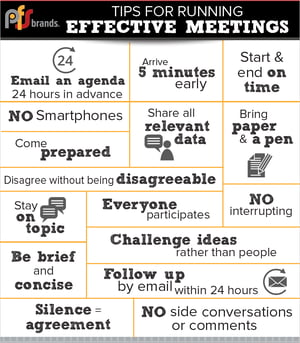Are Your Monthly Huddles Running Smoothly?
How often does your company hold business meetings? I’m not talking about the type of meeting to discuss the upcoming Christmas party, but actually getting all key managers together (or everyone dependent on company size) to discuss the key financials and KPIs from the previous week or month? It all comes back to open book management, keeping everyone in the loop, and keeping everyone with their eye on the prize!
Business Meetings 101
At PFSbrands we live by this principle. Not only do we hold monthly business meetings where the entire staff is invited (or remotes in) but there are weekly KPI meetings among management which then gets trickled back down to everyone. Heck, we even have cards in each meeting room to help keep everyone on track and aware of the meeting principles we follow (see below)! We are all on the same page and working towards the same goals – getting that flywheel moving in the same direction is a huge advantage for us!
Download your own PFSbrands Meeting Tip Card Here
It’s clear that these types of meetings can and will improve the communication in your office, but how do you run them properly? As with anything it’s all about effective, efficient meetings. Here’s some great meeting tips to grow your company:
Always start on time
Tick-tock…. Tick-tock…. Nothing like waiting for the last person to arrive to the meeting. This should be one of the concrete rules of your meetings – always start on time. If people are late, you start without them. Do this from the beginning and you won’t let that culture creep in!
Let the manager talk, you just guide the meeting
One common bad habit of many CEOs is that they completely take over the meeting and not allow their managers to explain their numbers. By going down the line from department to department and having the managers read off their key metrics and discuss any problems they are facing, you won’t get to the heart of increasing your bottom-line! You are basically there to guide the meeting and keep everyone on track.
Hold someone accountable for each key metric
As per the previous point, once you let everyone report their own key metrics, they own them. They are responsible for keeping track of them and working to improve them. This level of ownership not only helps improve the bottom-line but it also ensures that someone is always focused on improving the bottom-line for that specific department or metric.
Take that info back to rest of the department
Now that you have middle-management or department heads owning and improving your key numbers, you need to educate everyone else in the company. Have those managers take those numbers back to their department and report them to all of their coworkers – everyone from the office to external staff. From there they can divvy the numbers up even more and give individuals key metrics to own (KPIs). This keeps everyone on the same page and working towards the same goal.
Weekly, biweekly, monthly

There’s really no right answer here when it comes to how often you should meet, except that it should be at least monthly. If you feel like your team will benefit from weekly or biweekly meetings then give it a try. Try both timeframes and see what works best for your team and keeping their eye on the prize!
Keep it fun and keep it from becoming stale
When people are just going through the motions then mediocracy will reign supreme. Keep your staff engaged throughout these meetings by making sure they all truly understand the numbers. This might be a difficult task if you are just starting to instill ownership thinking but as your employees come to see how their actions affect the bottom-line and therefore profit distribution then they will be engaged and interested! So make sure to always instilling an ownership mindset when it comes to open book management in order to really get the most out of your business meetings.
Wrap-Up
Whether you call it a business meeting, a huddle, or your company’s power hour, these highly effective practices are great for getting everyone on the same page, instilling ownership thinking and getting the whole company trying to improve the bottom-line! Get on board, track the numbers, and see how it can help your company!
If you’ve missed any of our Business Communication Series check out Part 1!


